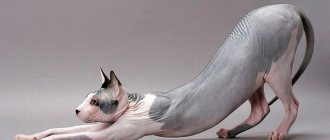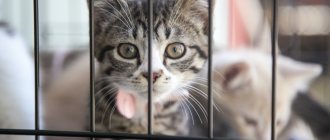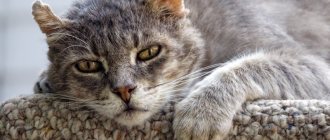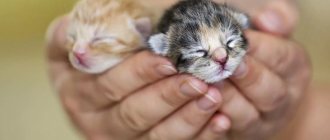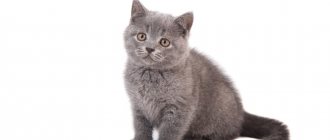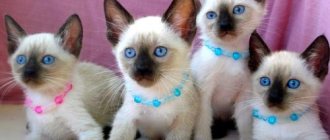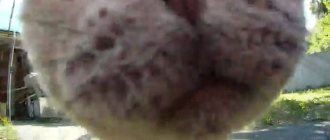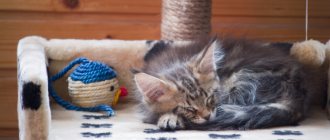Sphynxes are unusual cats that resemble aliens from another planet. Due to a genetic mutation and careful selection work, their body is completely or partially hairless. Because of this, representatives of the breed have a higher body temperature and require special conditions of detention.
Let's figure out how to care for the Sphynx in order to provide it with a comfortable and fulfilling life.
Preparing for the arrival of a kitten
In order for the process of weaning from its mother to take place without damage to the physical and psychological health of the little sphinx, it is taken to a new home no earlier than three months of age.
Representatives of this breed are usually reserved long before they are 12 weeks old. Therefore, happy owners have enough time to learn more about the features of caring for a kitten and prepare for its arrival.
To create decent living conditions for a hairless baby, they buy a “dowry” in advance:
- bowls for water, dry and wet food;
- carrying bag;
- tray with filler;
- scratching post;
- toys;
- grooming tools (nail clipper, toothbrush, etc.);
- hygiene products (ear cleaning lotion, toothpaste, etc.);
- bed or house.
In order to provide the little sphinx with not only proper care, but also safe living conditions, the apartment is also prepared for his arrival. Wires, indoor plants, household chemicals, fragile and small objects are hidden in advance from a curious and playful kitten.
On a note. When kept at home, inquisitive sphinxes try to explore every corner of their new property and often get into the most unexpected places like the oven or washing machine. To avoid tragedies, it is better to keep the doors of these devices closed, and before using the equipment, it is better to look inside once again to make sure that there is no little prankster in there.
Features of caring for the Sphinx
The exotic exterior cannot but affect the needs of the cat’s body. Therefore, it is better for potential owners to study in advance the features of care and maintenance of sphinxes.
Hairless cats have nuances with thermoregulation. Sphinxes do not tolerate dampness and drafts well. To protect representatives of the breed from hypothermia and colds, the room is maintained at a constant temperature within 20-25 °C. If this is not possible, the hairless cat is dressed up in a warm vest or blanket.
Sphynxes love warmth and love to bask in the sun. To prevent burns from leaving on the delicate skin, cats of this breed should not be exposed to ultraviolet rays for a long time.
Reviews about the breed
Dmitry Utiugov, 35 years old, Simferopol
I used to have a negative attitude towards cats that don't have fur. We got our Sphynx named Jerry with my wife when she was pregnant with her second child. After that, my attitude towards hairless cat breeds changed dramatically. These are extremely affectionate and friendly pets that do not leave behind any fur and get along well with children and their owners.
Irina Bulgakova, 39 years old, Moscow
I bought my girl Musya from a nursery. I decided to choose a hairless cat, because... I am allergic to cat fur. Now Canadians are my favorite breed.
The right diet
In order for the Sphynx to develop well and remain healthy longer, it is provided not only with proper maintenance and care, but also with balanced feeding. To remain active and maintain body temperature, hairless cats require more high-calorie food than representatives of shaggy breeds.
On a note. If the Sphynx's diet is low in fat, the animal will become cold and begin to overeat to make up for the lack of energy. And this is fraught with digestive problems.
With the industrial type of feeding, high-calorie products of premium or super-premium class are purchased for sphinxes. Before making a choice, you need to carefully study the description of the composition and make sure that it has sufficient fat content and there are no questionable components.
The following criteria are met:
- Royal Canin;
- Acana;
- Grandorf.
With a natural diet, the Sphinx's menu is designed so that it contains at least 70% meat. Also included in the diet of cats of hairless breeds is:
- boiled offal;
- porridge with water;
- vegetables;
- eggs;
- dairy products;
- lean sea fish.
It is important to ensure that cats of this breed never eat bones, baked goods, sweets, smoked meats, pickles and sausages. Also, sphinxes should not be given mushrooms, onions, river fish, fresh milk and any leftovers from the master's table.
What to feed?
Representatives of this breed have a wonderful appetite, but you cannot give them everything. This is especially true for table scraps and human food.
The digestive system of human bald friends is not adapted to digest confectionery or sausages, spices or smoked meats. It's poison for them. The diet is planned taking into account age characteristics.
Adults
Choose the number of feedings yourself, but it is better to accustom him to a certain regimen . The main thing is that your pet has access to food when he is hungry or cold. Meat must be on the menu. The daily value is approximately 30% of his body weight. There are also useful proteins in fish and cottage cheese. 200-250 g per day is enough.
1/3 of the food consists of carbohydrate components. These are porridges - buckwheat, oatmeal, rice or fresh vegetables. Add 5-10 g of vegetable oil to them. Unrefined is better, it contains more vitamins. In winter, the volume of portions increases.
What does a kitten need for normal development and growth?
The body grows up to 10 months, so it is important for babies to eat properly and fully. From the first month of life they are accustomed to solid food. Let's have some boiled veal. They can’t eat pork, it’s too fatty for them and can cause indigestion. From 6 weeks you can feed with egg yolk and cottage cheese. At 4 months, boiled sea fish is useful in small quantities. Remove the bones from it.
Training and education
The affectionate and sociable nature of Sphynx cats, combined with high intelligence and good memory, make them ideal pets suitable for home keeping. A well-mannered cat will not damage furniture, ride on curtains or do other dirty tricks. Therefore, it is extremely important to have time to form the correct model of behavior in the kitten in the house.
On a note. You need to raise a Sphinx without using physical force. To stop unwanted actions or calm down an overly naughty kitten, you can lightly shout at it, splash water, or hiss threateningly.
Raising a Sphinx includes training in hygiene procedures. The kitten is taught to be calm about bathing, trimming nails, rubbing eyes, cleaning ears and teeth.
Toilet training
Even if the breeder’s kitten regularly went to the litter box, this does not mean that in the new home he will not recover anywhere. Therefore, to prevent the apartment from turning into a latrine for a cat, from the first moment the pet appears, you need to pay attention to its toilet training.
Typically, kittens defecate after sleeping or eating. Noticing that the baby is about to go to the toilet, he is carefully picked up under the stomach and taken to the tray. As soon as he does his job, he will definitely be praised.
On a note. If the kitten went to the toilet in the wrong place, the puddle is blotted with a napkin, which is then placed in the tray. And the “crime scene” itself is wiped with water flavored with a small amount of citrus juice.
Feeding: main rules
High-quality, balanced nutrition for the Sphynx is the basis for good health and proper development. Already at the age of 3 months, the animal is allowed to give the first complementary foods. This can be natural food or specialized ready-made factory food intended for a certain age. The following Royal Canin brand foods have proven themselves to be:
- Mother&Babycat;
- Kitten.
Royal Canin brand food is suitable for such animals.
And for adults it is better to buy Sphynx Adult. If the owner prefers to feed from natural products, it is important to ensure that the menu has a balanced content of vitamins, minerals, and protein. Nutrition will be complete if you give your cat daily food such as:
- lean meat;
- boiled fish without skin and bones;
- vegetables: cauliflower, zucchini, pumpkin, boiled beets;
- cereals;
- hard unsalted cheese without additives;
- cottage cheese, kefir, yogurt, fermented baked milk.
In addition to quality nutrition, it is important to provide the animal with clean drinking water, which should always be fresh and freely available.
Hygiene
To ensure that the Sphynx always has a neat and aesthetic appearance, he is provided with regular care, which includes a whole range of hygiene procedures.
Bathing kittens and adult cats
Despite the lack of hair, Sphynx cats need regular washing. Therefore, bathing procedures should become an integral part of caring for these animals.
Sphynxes are bathed once a month using baby gels or special shampoos for hairless breeds.
Important! Sphynx cats should not be dried with a hairdryer so that the hot air does not burn the skin. Therefore, after bathing, cats of this breed are dried with a towel and lubricated with baby cream.
Skin care
Sphynx cats have no hair, and their sebaceous glands produce a lot of secretion, which accumulates and turns into a brown crust. It not only makes cats look unsightly, but also causes discomfort. If left untreated, over time, the skin underneath begins to itch and emit an unpleasant odor. As a result, a cat of this breed develops inflammation and dermatitis.
Therefore, an important aspect of Sphynx care is regular cleansing of the skin. The body of a hairless cat is systematically wiped with special wipes or a moistened cloth, paying special attention to the folds.
Important! Improper or irregular care of the Sphynx leads to the formation of black spots on the cat's skin. The comedones are carefully squeezed out, and the affected area is treated with an antiseptic.
Eyes
Since Sphynx cats do not have eyelashes, they are prone to eye diseases. Grooming for the breed should include regular eye examinations.
In healthy cats, clear or brown discharge accumulates in the corners. Therefore, the eyes of the sphinx should be wiped daily with a cotton swab dipped in boiled water or chamomile decoction.
Important! If yellow or green discharge appears in the eyes, it is advisable to show the cat to a veterinarian.
Teeth
Caring for a Sphynx cat includes cleaning its fangs and incisors. This procedure is carried out at least 2-3 times a month using a non-foaming paste applied to a silicone brush or a special attachment.
Systematic care of your cat's teeth will help get rid of plaque, help strengthen the gums and serve as a preventive measure against the formation of stones.
Ears
Hair cats grow in their ears, which prevents the penetration of dust and dirt. Hairless Sphynxes have unprotected ears. Therefore, even with strictly residential care, caring for cats of this breed involves mandatory cleaning of the ear canal.
The ears of sphinxes are regularly wiped with a clean cloth soaked in a special lotion or Vaseline oil.
Claws
To ensure that a cat living at home does not damage furniture and walls, caring for it should include regular trimming of its claws. The procedure is carried out using a nail clipper very carefully so as not to injure living tissues or cause pain to the cat. If representatives of the breed do not have their claws shortened, then a considerable amount of money for repairs and renovation of furniture can be added to the cost of keeping the cat.
How to educate?
With cats of this breed there are often no problems in raising them. Sphynxes are very clean; they never poop in a dirty tray that is not cleaned in a timely manner. Therefore, if the toilet is not kept clean, the animal may begin to shit in another place, where there is no dirt. Therefore, to prevent the cat from pooping anywhere, it is necessary to regularly clean the potty, and it is prohibited to use chlorine-containing products for disinfection.
These pets are quite easy to train.
Thanks to its well-developed intelligence, the animal is easy to train. It is important to conduct classes when the cat is in a good mood, but not immediately after feeding. Under no circumstances should you shout or offend the sphinx for not wanting to follow commands, postponing training for another time.
Vaccination
Sphynxes kept at home run the risk of becoming victims of viral and infectious diseases no less than their street counterparts. To protect cats of this breed from dangerous diseases, their care should include routine vaccination.
They are regularly vaccinated with a complex drug that stimulates the development of immunity to panleukopenia, calcivirosis and rhinotracheitis.
This is done for the first time when the kitten is 7-8 weeks old. After 4 weeks, the sphinx is revaccinated against the same diseases and against rabies. In the future, the cat is vaccinated annually, regardless of whether it is exclusively kept in an apartment or is on the street.
Important! Before vaccination, the animal must be subjected to antiparasitic treatment. Anthelmintic drugs are given to the cat 2 times with an interval of 10-14 days. The dose is calculated based on the pet's weight.
Origin story
There are many different legends about the Sphynx cat breed. It is believed that the cat first appeared in ancient times. The history of the breed goes back to ancient times, when they were revered as servants of deities and guides to the afterlife. How much truth there is in this is difficult to say.
How the Canadian Sphynx appeared is another story. In 1966, in Ontario (Canada), a cat gave birth to a hairless kitten, which was later named Prunta. Subsequently, the hairless cat gave birth to several more kittens. The breed was specially bred with hairless cats and female cats in order to preserve this unique gene.
Unfortunately, the Prunt gene was interrupted due to the fact that the kittens were born weak, and the breeders had little experience in working with this type of cat.
The furless kitten reappeared in 1975 in two different cats. Three more kids were found on the street. Already from this period, breeding of Canadian Sphynxes continued. In 1998, hairless cats were officially recognized.
